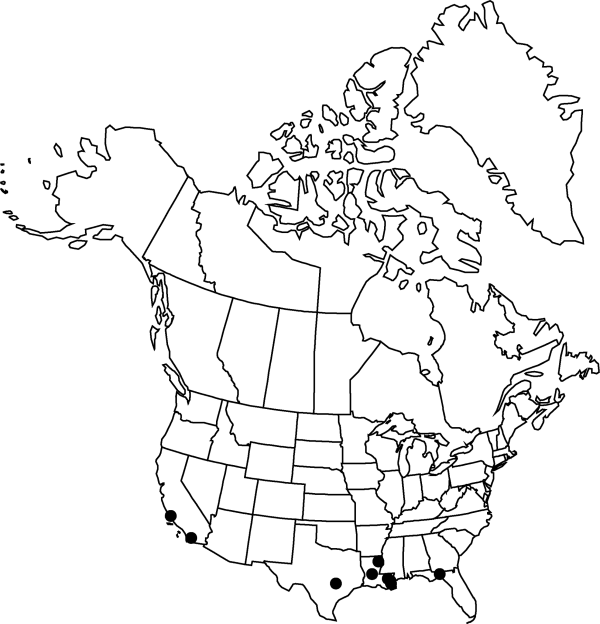Difference between revisions of "Anredera cordifolia"
Fl. Males. Ser. 1, 5: 303. 1957.
FNA>Volume Importer |
imported>Volume Importer |
||
| (6 intermediate revisions by 2 users not shown) | |||
| Line 8: | Line 8: | ||
}} | }} | ||
|common_names=Madeira-vine | |common_names=Madeira-vine | ||
| − | |basionyms={{Treatment/ID/ | + | |special_status={{Treatment/ID/Special_status |
| + | |code=I | ||
| + | |label=Introduced | ||
| + | }}{{Treatment/ID/Special_status | ||
| + | |code=F | ||
| + | |label=Illustrated | ||
| + | }} | ||
| + | |basionyms={{Treatment/ID/Basionym | ||
|name=Boussingaultia cordifolia | |name=Boussingaultia cordifolia | ||
|authority=Tenore | |authority=Tenore | ||
| + | |rank=species | ||
| + | |publication_title=Ann. Sci. Nat., Bot., sér. | ||
| + | |publication_place=3, 19: 355. 1853 | ||
}} | }} | ||
|synonyms={{Treatment/ID/Synonym | |synonyms={{Treatment/ID/Synonym | ||
|name=Boussingaultia gracilis | |name=Boussingaultia gracilis | ||
|authority=Miers | |authority=Miers | ||
| + | |rank=species | ||
}} | }} | ||
|hierarchy=Basellaceae;Anredera;Anredera cordifolia | |hierarchy=Basellaceae;Anredera;Anredera cordifolia | ||
| Line 30: | Line 41: | ||
|elevation=0-500 m | |elevation=0-500 m | ||
|distribution=Calif.;Fla.;La.;Tex.;Mexico;West Indies;Central America;Eurasia;Africa;Pacific Islands;Australia;native to South America. | |distribution=Calif.;Fla.;La.;Tex.;Mexico;West Indies;Central America;Eurasia;Africa;Pacific Islands;Australia;native to South America. | ||
| − | |discussion=<p>Anredera cordifolia is sometimes cultivated as an ornamental, and it escapes and naturalizes in subtropical to subtemperate regions (C. R. Sperling 1987). In many floristic treatments, it has been confused with A. baselloides (Kunth) Baillon, a species restricted to Ecuador and Peru. Fruit- and seed-set are rare in cultivated material; tubers are the main means by which Madeira- vine is propagated (C. R. Sperling 1987).</p> | + | |introduced=true |
| + | |discussion=<p><i>Anredera cordifolia</i> is sometimes cultivated as an ornamental, and it escapes and naturalizes in subtropical to subtemperate regions (C. R. Sperling 1987). In many floristic treatments, it has been confused with A. baselloides (Kunth) Baillon, a species restricted to Ecuador and Peru. Fruit- and seed-set are rare in cultivated material; tubers are the main means by which Madeira- vine is propagated (C. R. Sperling 1987).</p> | ||
|tables= | |tables= | ||
|references= | |references= | ||
| Line 39: | Line 51: | ||
-->{{#Taxon: | -->{{#Taxon: | ||
name=Anredera cordifolia | name=Anredera cordifolia | ||
| − | |||
|authority=(Tenore) Steenis | |authority=(Tenore) Steenis | ||
|rank=species | |rank=species | ||
| Line 54: | Line 65: | ||
|publication title=Fl. Males. Ser. | |publication title=Fl. Males. Ser. | ||
|publication year=1957 | |publication year=1957 | ||
| − | |special status= | + | |special status=Introduced;Illustrated |
| − | |source xml=https:// | + | |source xml=https://bitbucket.org/aafc-mbb/fna-data-curation/src/2e0870ddd59836b60bcf96646a41e87ea5a5943a/coarse_grained_fna_xml/V4/V4_1030.xml |
|genus=Anredera | |genus=Anredera | ||
|species=Anredera cordifolia | |species=Anredera cordifolia | ||
Latest revision as of 22:56, 5 November 2020
Stems twining to 5 m, often producing single or clustered axillary tubers. Leaves: petiole 6–12 mm; blade ovate to orbicular, 2–10 × 1–7 cm, base of larger leaf blades proximal to inflorescences cordate, base of small distal leaf blades tapering, apex obtuse to acute. Inflorescences racemes or in branched panicles of racemes, 10–35(–60) cm; single bract subtending each pedicel triangular-lanceolate, 1–2 × 0.3–0.4 mm; paired bracts subtending each flower persistent, triangular to obtuse, 0.6–1 × 0.5–0.6 mm, basally connate into cup. Flowers bisexual, usually functionally staminate; sepals basally adnate to petals, cream-white, not winged in fruit, ovate to elliptic, 1.2–2.3 × 1.1–2 mm, apex obtuse; petals basally connate, cream-white, ovate to elliptic, 2.1–3 × 1.4–2 mm, apex obtuse, spreading at anthesis; stamens fleshy; filaments basally connate and dilated, 1.9–3.5 mm; anthers early deciduous, 0.7–0.9 mm; pistils 0.4–0.6 mm; styles 1–1.5 mm, basally connate for 1/2–2/3 their length; stigmas clavate to capitate; pedicel 1–3 mm. Utricles rarely producing viable seeds, style bases persistent, globose, 0.8–1.1 mm. 2n = 24.
Phenology: Flowering late summer–fall.
Habitat: Disturbed areas, fencerows, roadsides
Elevation: 0-500 m
Distribution

Introduced; Calif., Fla., La., Tex., Mexico, West Indies, Central America, Eurasia, Africa, Pacific Islands, Australia, native to South America.
Discussion
Anredera cordifolia is sometimes cultivated as an ornamental, and it escapes and naturalizes in subtropical to subtemperate regions (C. R. Sperling 1987). In many floristic treatments, it has been confused with A. baselloides (Kunth) Baillon, a species restricted to Ecuador and Peru. Fruit- and seed-set are rare in cultivated material; tubers are the main means by which Madeira- vine is propagated (C. R. Sperling 1987).
Selected References
None.
